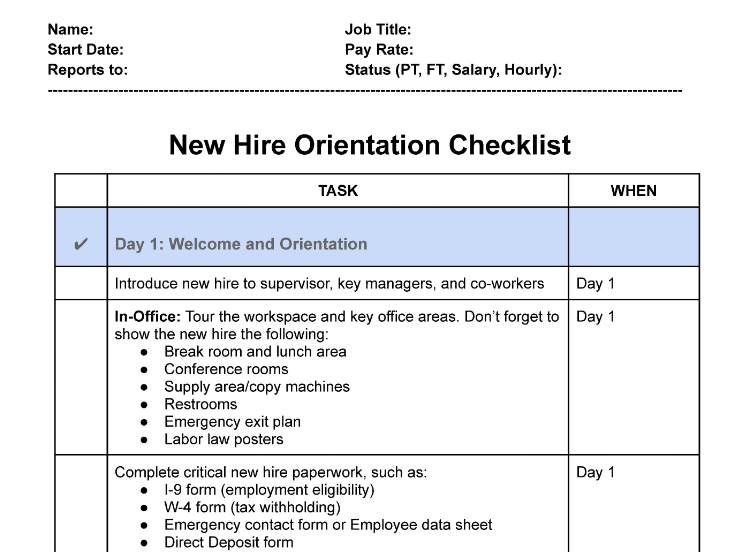A new hire orientation is the first official experience new hires have with their employers after joining the team. A well-designed new employee orientation program should offer a good introduction to the company’s culture, clarify the new hire’s job duties, and provide an opportunity to complete the required paperwork. It should also include presentations, training sessions, and access to the tools needed for success.
Here’s a step-by-step guide to help you create an efficient orientation for new hires that will make them feel valued.
These steps don’t include pre-onboarding tasks like preparing new hire paperwork, requesting company computers and access badges, and arranging one-on-one meetings with key staff members. You should also create the orientation schedule and include it in the welcome email you send to new hires. Don’t forget to share other information, such as the company’s dress code (e.g., business professional or business casual) and the expected reporting time for the first day.
Use a checklist to ensure you provide the best experience possible. You can download and modify the new hire orientation checklist below, which includes all the basic new employee orientation tasks.
Step 1: Welcome and introduction sessions
Once you’ve completed the process of hiring employees, new hires will soon be ready to begin their first day on the job. Your primary focus should be welcoming them and facilitating smooth introductions. Here are key activities to consider:
Step 2: Manage new hire paperwork
New hire paperwork is essential for a new employee, but it can be overwhelming. Instead of handling a stack of documents to complete, break it down into manageable steps.
- Send the onboarding requirements in advance, as it allows new hires to complete some of the paperwork before their first day.
- Offer a guided walkthrough of important policies to ensure that new employees understand them.
- If more than one new hire starts on the same day, conduct a group session to review policies and the employee handbook together.
- Use online HR platforms to streamline onboarding, paperwork collection, and document signing with electronic signatures.
- Set clear deadlines for submissions and send automated reminders.
Many online software make it easy to onboard employees and store digital paperwork for both on-site and remote employees. For options, check out our guides to the best onboarding software and leading HR systems, which usually include onboarding tools.
Step 3: Provide orientation video (recommended)
A company orientation video is an effective way to introduce new hires to the company’s history, workplace culture, and benefits offered to new employees. If you’ve yet to create one, consider a one-on-one session with HR instead. Check out the one our in-house HR team recorded if you need a video example to follow:
Orientation videos should be informative, enthusiastic, and short. (Source: TechnologyAdvice)
Orientation videos should be informative, enthusiastic, and short. (Source: TechnologyAdvice)
When using onboarding software, you can add viewing the video as part of the new staff orientation checklist. Some software even make it easy to track completed assignments and sends reminders if a task is not met.
Things to include in the orientation video or one-on-one session are:
- Company history: Assume that your new employee knows nothing about your company. Including a document (or PowerPoint presentation) that shares the entire history of the company helps endear the new hire to their new employer.
- Workplace culture: Company culture encompasses all the many values and behaviors of the company, its employees, and its brand. Taking the time to explain the company’s culture thoroughly helps the new team member become more grounded in how their role fits into the larger picture.
- Mission, vision, and values: New employees need to know and understand the company’s vision, values, and mission statement, which is the organization’s charter and reason for being.
- Employee benefits: Although this is part of the welcome materials, company benefits should be highlighted during the orientation video as well. This will also be the time for the new employee to ask questions related to their benefits. Learn about the different types of benefits in our guide.
- Company policies: These are typically in writing and in the employee handbook, but you should provide a quick overview of the main company policies, such as work hours, availability, and safety rules.
Step 4: Offer training sessions
Provide training sessions to help new hires understand their role and company processes. You can design these training sessions using your HR software or an Excel spreadsheet. Use tools like HR software checklists or Excel to organize learning sessions, which can include in-person meetings, video tutorials, or online courses with quizzes.
Check your training and development program for the list of essential functional and compliance courses that new employees should complete based on their position or level. Some new hire orientation ideas you should include in training sessions are:
- “How to” videos describing the software used at your company — QuickBooks, Salesforce, timeclock entries, etc.
- Department or job-specific training videos
- Cross-functional understanding workshops
- Non-discrimination and harassment prevention courses

Training videos can be a good way to demonstrate practices or issues that are not easily explained or are uncomfortable to discuss, such as in this preview of sexual harassment prevention training. (Source: MediaPartners on YouTube)
Don’t overwhelm new hires with back-to-back training courses on their first day. Schedule orientation sessions and training schedules throughout their first week or longer. Give them time to absorb the information and apply it to their new roles. I also suggest providing online training courses, making it easy for employees to learn at their own pace and also save trainer time — but be sure to set deadlines.
Step 5: Allow new hire to acclimate to new position
An important step in orientation is giving your new hires the time to adjust to their new job and workplace. To give them the support they need, consider these strategies:
- Job shadowing: Have your new hires shadow a peer so they can see what a day in the life of a co-worker looks like. Seeing firsthand what the day-to-day activities are enables them to gain an in-depth understanding of their role or a particular job
- Celebrate small wins: Acknowledge the new hires’ milestones, such as completing their first task or finishing all required training programs. This builds confidence, boosts employee engagement, reinforces your investment in their growth, and fosters a culture of recognition.
- Supervisor check-ins: Ensure their supervisor plans times over the next few weeks up to the first month to check in and see how new hires are progressing. These can be formal meetings or a simple touch-base at the employee’s desk.
Orientation for remote employees
The orientation for new employees who work remotely follows a similar structure to on-site onboarding but is tailored for a virtual environment. Since all introductions, paperwork, and training are online, it’s important to keep the process clear, engaging, and well-organized.
Some best practices include:
- Send new hire paperwork in advance: This can ensure that the required documents are completed and submitted in a timely manner. Plus, new hires don’t need to spend their entire first day filling out forms. Set up a process for verifying I-9 documents in person by an authorized representative (such as a notary public).
- Create a structured onboarding plan: Outline key milestones, objectives, and a timeline for the new hires’ first few weeks.
- Host a virtual welcome meeting: Schedule an all-company video call to introduce the new hires to the rest of the team. This can be done during a regular full company meeting or a special session on their first day. Don’t forget to set up a separate video call with new hires’ respective managers and team members.
- Combine remote and in-house orientation programs: Consider using a video service, such as Zoom, to conduct an orientation for new staff with the same hire dates but have different working conditions, such as on-site, hybrid, or fully remote. If your orientation is a video, simply host the video online and provide a link for new hires to view. However, let them know how to reach you if they have questions after watching.
- Provide virtual training modules: Offer online courses of department and job-specific training programs. Consider adding quizzes to reinforce key concepts and ensure comprehension as needed.
- Check in regularly: Connect with your new hires virtually on a daily basis for the first few days to ensure they’re adjusting well. After that, schedule periodic check-ins at the first 30, 60, and 90 days to provide ongoing support.
New hire orientation vs onboarding: A comparison
Onboarding and orientation are closely related, but they serve distinct purposes in welcoming new hires. Think of orientation as the “kickoff” and onboarding as the “journey. Understanding the differences between these is crucial for developing effective employee integration strategies.
New hire orientation | New employee onboarding | |
|---|---|---|
Purpose | Introduces company basics, policies, office logistics, and team members | Integrates employees into their new role, team, and workplace culture |
Duration | Short-term (one day to one week) | Long-term (weeks to months) |
Focus | Immediate needs: Paperwork, office tours, and introductions | Gradual development: Training, mentorship, and culture immersion |
Customization | Standardized for all new hires | Tailored to specific roles and career paths |
Outcome | Helps employees feel welcome and ready to start | Builds engagement, productivity, and long-term success |
Want to learn more? Check out our article that contains new employee orientation tips from various HR managers and business leaders.
New employee orientation frequently asked questions (FAQs)
In addition to welcoming employees, an orientation for new staff allows them to learn more about the company and their new roles. Further, employees who are well-oriented are more likely to be satisfied with their jobs and stay with the company longer. This is because they have a better understanding of the company’s expectations, their job duties, and the opportunities for growth and development.
Generally, an effective orientation typically spans five days, including training hours. However, these can sometimes take longer, depending on the company and role.
Yes! Onboarding is a paid part of the job under the Fair Labor Standards Act (FLSA) — unless it meets four criteria: occurs outside work hours, involves no actual work, is unrelated to work, and is optional (team members can decline without penalty). For example, unpaid activities might include a voluntary after-hours social event, while mandatory online training courses must be compensated. Also, you should pay employees for work-related onboarding tasks, even if completed remotely.



